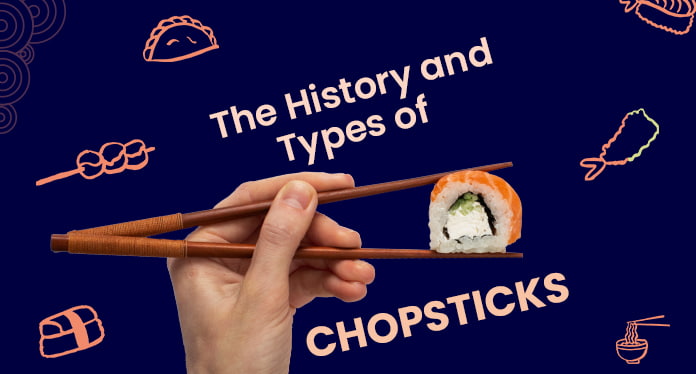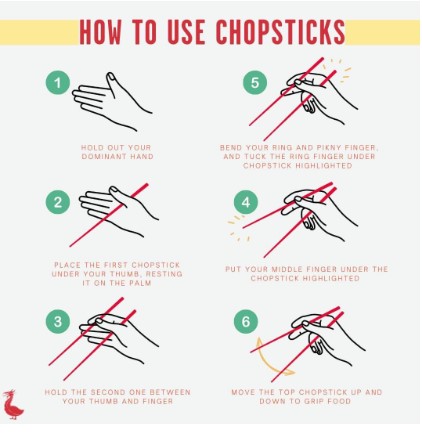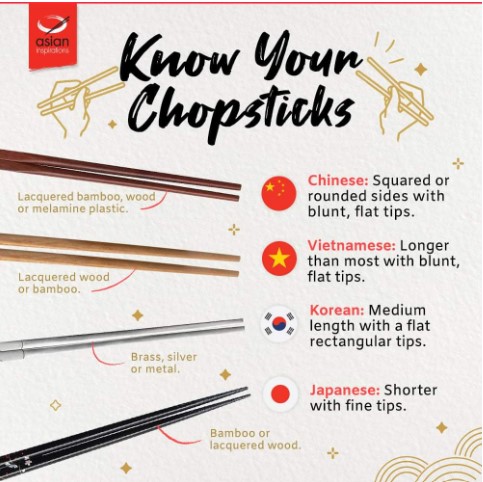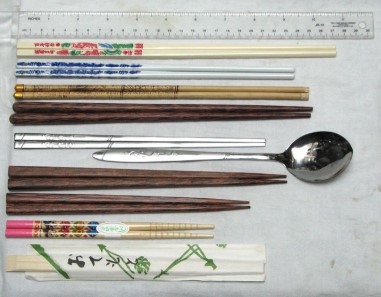History And Types Of Chopsticks (2025)

The history of chopsticks dates back thousands of years. It all started in China around 1200 BCE when they were used as cooking tools made from twigs. The first known use of chopsticks for dining can be found during the Han Dynasty (206 BCE – 220 CE) as a response to food scarcity; smaller portions were prepared, making chopsticks an ideal utensil for picking up bites of food.
As Chinese culture spread, so did the use of chopsticks, reaching Japan, Korea, and Vietnam. Each culture developed its own unique style and etiquette around these utensils. Japanese chopsticks are more tapered, while Korean chopsticks are metal, and Chinese chopsticks have a blunt end.
Today, 1.5 billion people around the globe use chopsticks every day to eat. In this post, we explore the history and types of chopsticks to understand one of the oldest utensils.
Timeline of Chopsticks Usage
1200 BCE: The earliest known use of chopsticks dates back to ancient China during the Shang Dynasty. At this time, chopsticks were made from bronze/twigs and were primarily used as cooking tools rather than for eating.
206 BCE – 220 CE (Han Dynasty): Chopsticks began to be used for eating as food started being cut into smaller pieces to conserve fuel. This transition marked chopsticks as an everyday dining utensil in China.
5th Century CE: The spread of Buddhism played a role in popularizing chopsticks across East Asia. As Buddhism discourages the use of knives at the table, chopsticks became preferred for their gentler, non-violent use.
500-600 CE: Chopsticks spread from China to Japan, Korea, and Vietnam, each country adapting the design and materials to suit local customs. In Japan, chopsticks became shorter and more pointed to accommodate Japanese cuisine centered around boiled veggies and fish.
7th Century: In Korea, metal chopsticks began to appear, especially among royalty, due to the practicality and durability of metal. Brass or silver was often used as a status symbol and later as a way to detect poison.
17th Century (Edo Period in Japan): Lacquered wood chopsticks became popular in Japan, often decorated with intricate designs. Different sizes and styles were developed, including shorter chopsticks for women and children.
19th Century: Chopsticks began to be mass-produced as the materials diversified, including bamboo, wood, and metal. Their usage continued to spread internationally, especially as Asian communities settled in other countries.
20th Century (1900s): Disposable chopsticks, known as waribashi, were introduced in Japan, which increased the popularity of chopsticks worldwide. These disposable versions were especially practical for restaurants.
21st Century (Current Times): 1.56 billion people across the globe east with chopsticks. They are available in a range of materials, such as plastic, stainless steel, and bamboo.
How to Hold Chopsticks
The way people hold chopsticks differs from country to country. In Japan and Korea, people often grip chopsticks near the back third of the stick. In China, however, they are usually held in the middle, while in Vietnam, people tend to hold them closer to the front.
 Image source: Cold Guides Reddit
Image source: Cold Guides Reddit
Chopstick Usage Techniques
There are also different ways to use chopsticks across countries. In China and Korea, the "pinch method is common, where the bottom chopstick stays still, and the top chopstick moves to grab food. In Japan, people sometimes use a "stabbing technique to break certain foods like tofu apart.
Respectful Etiquette with Chopsticks
Each country has its own rules for respectful chopstick use:
- In Japan, rubbing chopsticks together is seen as rude, as it suggests they are of poor quality.
- In China, it's normal to use chopsticks to pick up food from shared dishes instead of using a serving spoon.
- In Korea, leaving chopsticks sticking upright in a bowl of rice is disrespectful, as it resembles a funeral ritual.
Chinese, Japanese and Korean Chopsticks (How Are They Unique)
 Image Source: Cool Guides Reddit
Image Source: Cool Guides Reddit
Chinese Chopsticks
Chinese chopsticks are the longest of the three, averaging 10 to 12 inches in length. Usually made from wood, bamboo, or plastic, they have a blunt, square or round tip. The extra length helps with reaching dishes that are often shared at a large table. Chinese chopsticks are often plain but may also have decorative designs.
Japanese Chopsticks
Japanese chopsticks are shorter and more tapered than Chinese ones, with a pointed end that makes it easier to handle Japanese foods like sushi and breaking down fish from tiny bones.
They are often made from lacquered wood and come in a variety of sizes. Japan also has specific chopsticks for cooking and serving.
Korean Chopsticks
Korean chopsticks are flat and often made from metal, traditionally brass or stainless steel. They are shorter than Chinese chopsticks but longer than Japanese ones. They are often paired with a metal spoon, with both utensils used for eating meals.
Types of Chopsticks Based on Material
 Image Source: Wikipedia
Image Source: Wikipedia
- Wooden Chopsticks: Used often in China and Japan, wooden chopsticks are light and easy to hold. They can be plain or have a shiny finish with decorations.
- Bamboo Chopsticks: Bamboo chopsticks are good for the environment, affordable, and don't slip easily. They're a popular choice for everyday use.
- Metal Chopsticks: Commonly used in Korea, metal chopsticks (usually stainless steel) are strong and last a long time. They are flat, making them a bit harder to use, but they're very clean and durable.
- Plastic Chopsticks: These chopsticks are cheap, colorful, and light. They're mostly used for casual meals, but some types aren't heat-safe, so they aren't usually used for cooking.
- Bone or Ivory Chopsticks: In the past, bone and ivory chopsticks were used by Chinese royalty. They're fancy and expensive but rare today due to conservation efforts.
- Disposable Chopsticks (Waribashi): Made from bamboo or wood, these single-use chopsticks are common in Japanese and Chinese restaurants. They're convenient but create a lot of waste.
- Porcelain or Ceramic Chopsticks: Porcelain or ceramic chopsticks are often beautifully decorated, but they're fragile. People usually use them on special occasions or give them as gifts.
Types of Chopsticks Based on Usage
- Cooking Chopsticks (Saibashi): These are extra-long chopsticks, usually over 12 inches, used in Japan and China for cooking. The length helps keep hands away from heat when frying or stirring.
- Eating Chopsticks: These are regular chopsticks used for eating. The size and shape differ by country: China's are long and square, Japan's are shorter and pointed, and Korea's are flat.
- Serving Chopsticks: These are separate chopsticks, sometimes longer, used to move food from shared dishes to your plate to keep things clean.
- Children's Chopsticks: These are shorter chopsticks with special grips to help kids learn how to use them. In Japan, they come in fun colors and designs with characters.
- Gift or Souvenir Chopsticks: These chopsticks are beautifully decorated, often with carvings or designs, and are meant to be given as gifts rather than used daily.
Answering Some Common Questions About Chopsticks
When were chopsticks invented?
Chopsticks were first used about 5,000 years ago in ancient China, around the time of the Shang Dynasty (1600-1046 BCE).
Are there rules for using chopsticks?
Yes, there are some basic rules. For example, it's considered rude to use chopsticks to stab food. It's also disrespectful to cross chopsticks or leave them standing upright in a bowl.
What materials are chopsticks made from?
Chopsticks are made from many materials, including wood (bamboo and hardwood), metal (stainless steel or brass), disposable plastic, lacquered wood, and other composite materials.
Are there any health benefits to using chopsticks?
While mainly a cultural tool, using chopsticks encourages slower eating and smaller bites, which can help with mindful eating. They also allow you to avoid picking up too much oil or sauce. These health benefits mostly come from these eating habits, not from chopsticks themselves.



